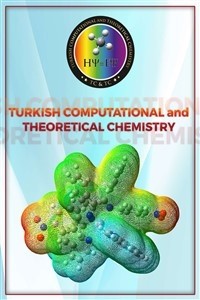The thermo physical, HOMO, LUMO, Vibrational spectroscopy and QSAR study of morphonium formate and acetate Ionic Liquid Salts using computational method
The thermo physical, HOMO, LUMO, Vibrational spectroscopy and QSAR study of morphonium formate and acetate Ionic Liquid Salts using computational method
Morphine is considered as the uncountable pain killer drug which is taken by both of mouth or injection. In this case, morpholinium ILs is the most applicable molecules due to liquid range so that the thermo-chemical, chemical reactivity and biological interaction of most expected morphonium formate and acetate ILs is considered under theoretical study by HyperChem 8.010 computer programming method. Some thermodynamic parameters such as free energy, entropy, dipole moment, binding energy, nuclear energy, electronics energy, heat of formation and QSAR properties of molecules like charge density, surface area grid, volume, LogP, polarizability, refractivity, molecular mass, and reactivity properties of molecule like HOMO, LUMO, HOMO-LUMO, ionization potential and electron affinity were determined using the HyperChem 8.0.10 programme. The morphonium formate is less biological active than morphonium acetate because LogP is 1.19 and -0.66 respectively. On the other hand, the HOMO LUMO gap in all transition level almost same that indicate similar chemical reactivity. The binding energy of both molecules is -3078.01 and -3351.25 kcal/mol respectively. The vibrational spectroscopy data provides them the identification and characterization.
___
- [1]D.G. Ramachandran K.I., Krishnan Namboori. P.K. -Verlag GmbH ISBN -3-540-, Computational Chemistry and Molecular Modeling Principles and applications. Springer 77302-77303.[2]C. T., A Handbook of Computational Chemistry, in, Wiley, New York, 1985.[3]W.M. Reichert, Holbrey, J.D., Swatloski, R.P., Gutowski, K.E., Visser, A.E., Nieuwenhuyzen, M., Seddon, K.R. and Rogers, R.D., Solid-State Analysis of Low-Melting 1,3-Dialkylimidazolium Hexafluorophosphate Salts (Ionic Liquids) by Combined X-ray Crystallographic and Computational Analyses. Cryst. Growth Des 7 (2007) 1106-1114.[4]L. Martini, J.L. Whistler, The role of mu opioid receptor desensitization and endocytosis in morphine tolerance and dependence. Current opinion in neurobiology 17 (2007) 556-564.[5]W.D. Bowen, S. Gentleman, M. Herkenham, C.B. Pert, Interconverting mu and delta forms of the opiate receptor in rat striatal patches. Proceedings of the National Academy of Sciences 78 (1981) 4818-4822.[6]T.J. Coderre, A.L. Vaccarino, R. Melzack, Central nervous system plasticity in the tonic pain response to subcutaneous formalin injection. Brain research 535 (1990) 155-158.[7]T.J. Coderre, J. Katz, A.L. Vaccarino, R. Melzack, Contribution of central neuroplasticity to pathological pain: review of clinical and experimental evidence. Pain 52 (1993) 259-285.[8]H.J. Groenewegen, F.T. Russchen, Organization of the efferent projections of the nucleus accumbens to pallidal, hypothalamic, and mesencephalic structures: a tracing and immunohistochemical study in the cat. Journal of Comparative Neurology 223 (1984) 347-367.[9]D. Van Der Kooy, R.F. Mucha, M. O'Shaughnessy, P. Bucenieks, Reinforcing effects of brain microinjections of morphine revealed by conditioned place preference. Brain research 243 (1982) 107-117.[10]A. Mansour, H. Khachaturian, M.E. Lewis, H. Akil, S.J. Watson, Anatomy of CNS opioid receptors. Trends in neurosciences 11 (1988) 308-314.[11]K. Tsou, S. Brown, M. Sanudo-Pena, K. Mackie, J. Walker, Immunohistochemical distribution of cannabinoid CB1 receptors in the rat central nervous system. Neuroscience 83 (1998) 393-411.[12]T.L. Yaksh, T.A. Rudy, Analgesia mediated by a direct spinal action of narcotics. Science 192 (1976) 1357-1358.[13]L.A. Dykstra, D. McMillan, L. Harris, Antagonism of morphine by long acting narcotic antagonists. Psychopharmacologia 39 (1974) 151-162.[14]I. Izquierdo, Effect of naloxone and morphine on various forms of memory in the rat: Possible role of endogenous opiate mechanisms in memory consolidation. Psychopharmacology 66 (1979) 199-203.[15]I. Newington, J.M. Perez-Arlandis, T. Welton, Ionic liquids as designer solvents for nucleophilic aromatic substitutions. Organic Letters 9 (2007) 5247-5250.[16]M.I. Hossain, A. Kumer, S.H. Begum, Synthesisand Characterization of Ammonium Benzoate and Its Derivative Based Ionic Liquids and Their Antimicrobial Studies.[17]M.I. Hossain, A. Kumer, Synthesisand Characterization of Ammonium Ionic Liquids and Their Antimicrobial and Computational Overview.[18]A. Kumer, B. Ahmed, M.A. Sharif, A. Al-Mamun, A Theoretical Study of Aniline and Nitrobenzene by Computational Overview.[19]A.H. Shapiro, The Dynamics and Thermodynamics of Compressible Fluid Flow: In Two Volumes, Wiley, 1953.[20]E.A. Guggenheim, Thermodynamics-an advanced treatment for chemists and physicists. Amsterdam, North-Holland, 1985, 414 p. (1985).[21]L. Von Bertalanffy, The theory of open systems in physics and biology. Science 111 (1950) 23-29.[22]A. Howard, J. McIver, J. Collins, Hyperchem computational chemistry. Hypercube Inc., Waterloo (1994).[23]R. Mulliken, Electronic population analysis on LCAO–MO molecular wave functions. II. Overlap populations, bond orders, and covalent bond energies. The Journal of Chemical Physics 23 (1955) 1841-1846.[24]A.R. Ortiz, M.T. Pisabarro, F. Gago, R.C. Wade, Prediction of drug binding affinities by comparative binding energy analysis. Journal of medicinal chemistry 38 (1995) 2681-2691.[25]L. Timofeeva, N. Kleshcheva, Antimicrobial polymers: mechanism of action, factors of activity, and applications. Applied microbiology and biotechnology 89 (2011) 475-492.[26]K.D. Collins, Charge density-dependent strength of hydration and biological structure. Biophysical journal 72 (1997) 65-76.[27]M. Böhm, J. Stürzebecher, G. Klebe, Three-dimensional quantitative structure− activity relationship analyses using comparative molecular field analysis and comparative molecular similarity indices analysis to elucidate selectivity differences of inhibitors binding to trypsin, thrombin, and factor Xa. Journal of medicinal chemistry 42 (1999) 458-477.
- ISSN: 2587-1722
- Başlangıç: 2017
- Yayıncı: Koray SAYIN
